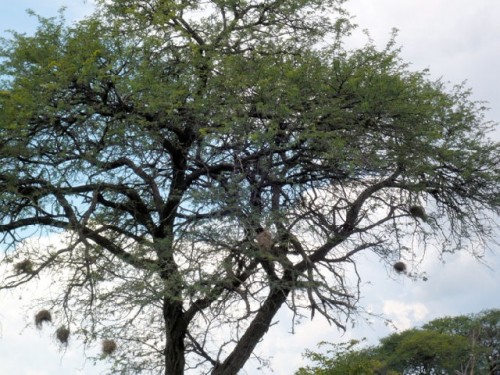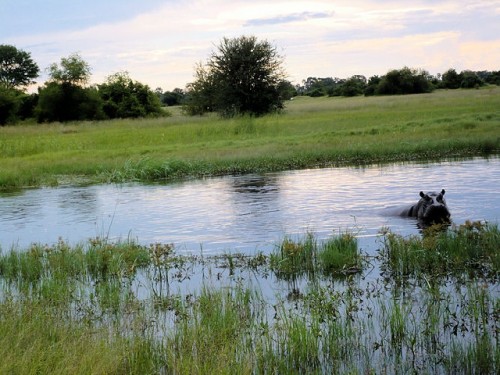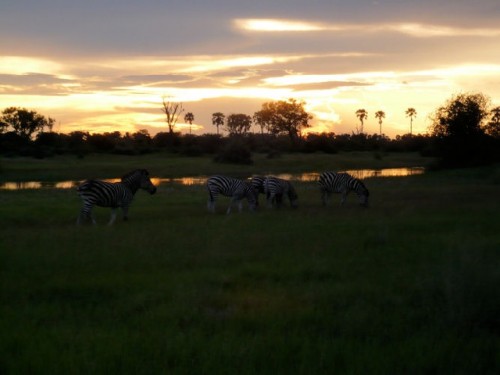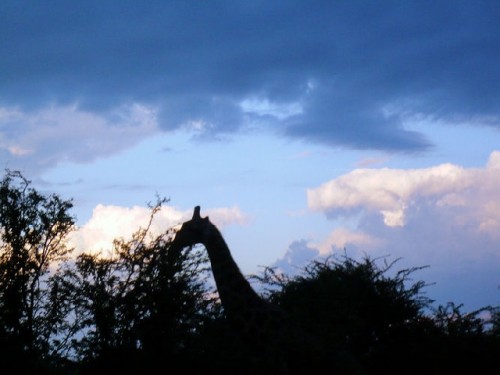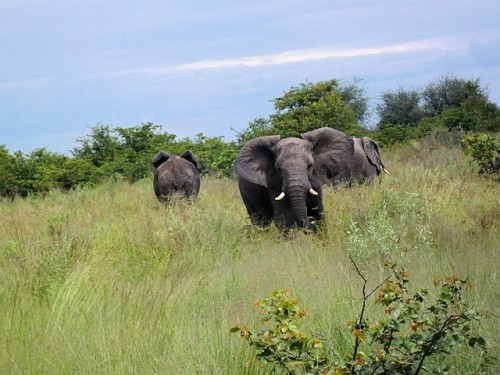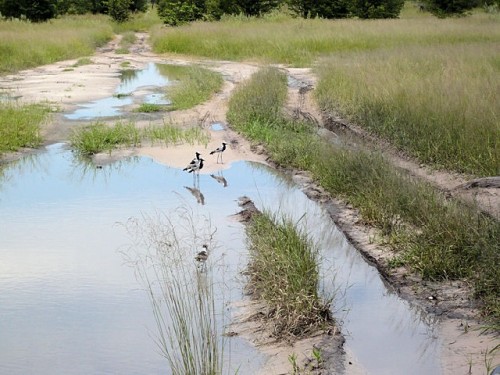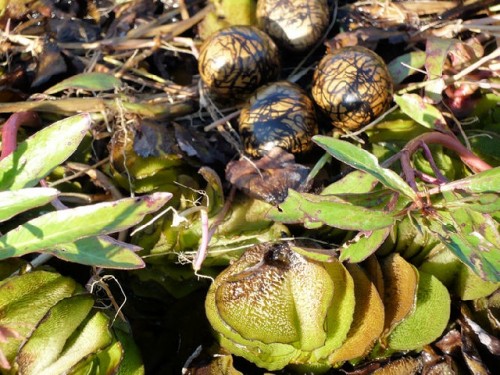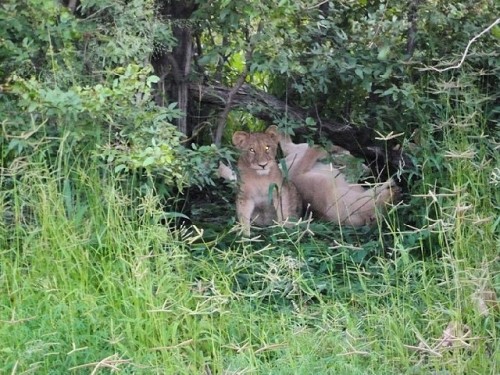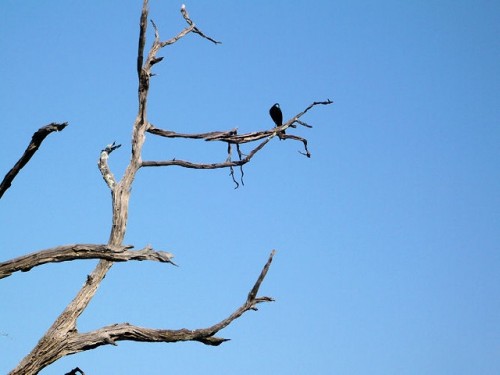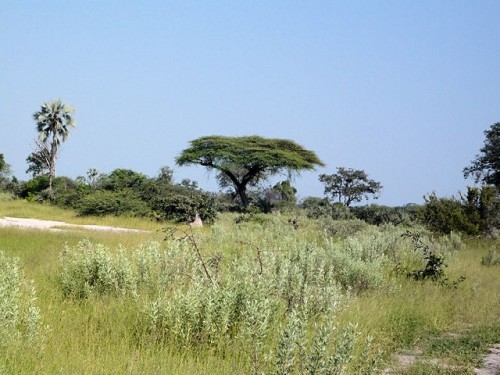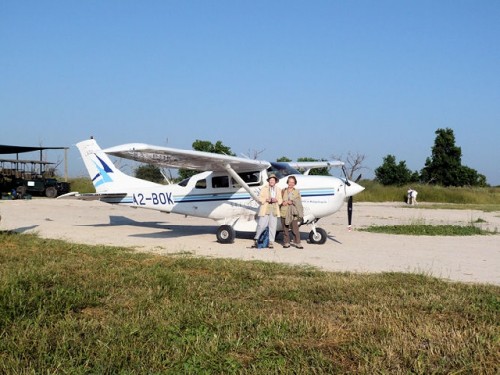Reports on Southern Africa: Part Three
The Okavango Delta, Botswana
By: Zeren Earls - Mar 30, 2008
To get to the Okavango Delta we traveled by boat, once again to the Kwando air strip, and flew back to Botswana. It was a clear day, making it possible for the Cessna Caravan to fly close to the ground over the hues of green below. As we approached the landing strip, we got a bird's eye view of giraffes and zebras. Met by our local guides, we transferred to land rovers for the ride to the private Wilderness Tented Camp adjacent to the border of the Moremi National Park in the northern region of the Delta. On the way we stopped to look at birds: Red billed buffalo weavers, starlings, ostriches and pygmy geese.
On arrival, we were briefed about the camp and advised to put our passports, money and any other valuables in locked bags, which were kept in a safe in the main lodge. This was the same in every camp. The tents were spacious with private bath and shower. Our welcome lunch included quiche, green salad with chunks of cheese, and another salad of apples and raisins. Following a period of relaxation we left for a game drive.
The Okavango Delta is created by northern rivers coming from Angola. After the rainy season the floodwaters begin their slow journey southwards and upon reaching Botswana fan out into the Delta. This dispersed water never reaches the sea; instead it vanishes into the Kalahari Desert, leaving a lush oasis for hundreds of water-dependent species. As our land rover made its way through a web of paths and trails, we saw elephants by watering areas, zebras, hippos, and many large and small water birds. Hippos emerged randomly from beneath the water, blowing a cloudy mist through their nostrils before taking another breath to dive below the surface.
Our return to camp was adventurous, as we had to get off the land rover and push it to get the engine started. While the driver made his way through winding dirt roads, which often held water up to two or more feet deep, his assistant held a bright lamp to ward off animals in the night. Finally back at camp around 8 pm, a festive dinner set for Valentine's Day soothed earlier anxieties from the game drive. We popped open a bottle of champagne courtesy of the lodge manager, Peggy Sue. Dinner included leek soup, beef stew, rice, carrots, broccoli and salad, topped with crème caramel for dessert.
The next day was our much anticipated trip by mokoro, a traditional dugout canoe. On the way to the Gomoti Channel, the sun broke through the clouds like a gorgeous painting and giraffes feeding by lush trees completed the early morning tableau. After we donned our life jackets and got on the Channel in canoes, it began raining hard. We had to return to land because, according to our guide, it would be difficult to discern hippos' air bubbles among big rain drops. This was one of the few times it rained during the day, so we spent time browsing in the lodge's small curio shop. This was lucky for me because I became the proud owner of a beautifully carved sable antelope.
The weather cleared in time for a short game drive before lunch. Because of the rain, previously invisible spider webs glistened like crystals in midair. On the ride, our guide spotted fresh lion tracks on the sandy road and followed them into the bush. After several changes of direction, he finally located a female lion. We stopped close to it, and saw another female with her cubs hiding in a clump of bushes nearby. The two adults were wary and amazingly still. We were advised to keep our voices down and not make any sudden moves. It was fascinating if a bit frightening to be so close to lions who were watching us so carefully. Since we had not seen any lions earlier, our guide contacted the guide in the other land rover and, to our amazement, was able to give him directions to where we were. We were all able to take a few pictures. On the way back we became the target of a mother elephant's mock charge, but again bravely were able to take a quick picture before driving away.
In the afternoon we were given a behind-the-scenes tour of the camp facilities: the kitchen and bakery, the storage area for produce and staples, the laundry room, the mechanic's garage and the sleeping quarters for the staff. It takes a staff of nineteen, including guides, boatmen and mechanics, to run the camp for each group of sixteen visitors. The camp employs a total of twenty-five people to allow staff to work on a rotating basis throughout the year. The staff gets up at five to have breakfast, including freshly baked goods, ready by six. The laundry is done by hand and pressed by charcoal- filled irons, which reminded me of my boarding school days in Istanbul. The safari vehicles are maintained by a mechanic on the premises.
Clear skies in the evening allowed us to explore the Delta by mokoro. Our boatmen, all from the same tribe, had grown up on the Delta in homesteads near the city of Maun. They had learned how to make the dugout canoes as boys and used them for transportation their whole lives. However, canoes are made of durable fiberglass now, as was the case for ours. Our boatman navigated the two passenger mokoro through the channels across the open floodplains. We moved quietly through the Delta, meandering through long strands of ribbon channels and a sea of papyrus. Dense gardens of aquatic vegetation bordered the sandy riverbeds. Within the tangled vegetation we spotted small fish and moorhen eggs. The diversity of life in these serene waters was a feast for the senses.
A lecture by our local guide, K. B., nicknamed King of the Bush, provided further information on the Okavango Delta. It is the largest untouched inland delta in the world and hence has a fascinating ecosystem that plays host to a myriad of animal, bird and plant life. It receives 70% of its water from rivers in Angola; the remaining 30% is rain water. Because of the heat, all but 2% of the water evaporates. Flat open plains offer little resistance to the winds, which blow across the Delta accelerating the evaporation. During the dry season, all but two or three rivers dry up completely, making it possible to walk on most of the Delta. Angola is considering building a dam, which would destroy the current habitat.
During the rainy season the sandy terrain is dense with tall grasses, and bushes are full of lush foliage, which makes it difficult to see the animals. Since the lions we had seen earlier in the day were the only ones we had seen so far, we returned to look for them again that evening. They were in the same spot. Evening is the time lions are active and go out hunting; we watched the cubs at play for a little while and then drove off.
The evening meal was a birthday celebration for Kay, another member of our group. The game drives on our final day in Botswana were full of wildlife splendors: Giraffes, elephants, kudus, impalas, ostriches and zebras on the ground; hippos in the water and egrets by the water; francolins in puddles; birds on dead trees; and vultures, eagles and many other birds in the air. We learned to distinguish the palm that spreads like a fan from the palm that bears a fruit called "vegetable ivory". Of the four-layered fruit the second layer with the white flesh is eaten, while the third layer is used to make necklaces. The candle-pod and umbrella acacias matched their picturesque popular names.
One of our guides, a Bushman from the San tribe, demonstrated his native language by producing clicks with his tongue, and talking about past traditions. Boys learned to track animals and kill buffalos before puberty. Initiation rights required them to spend a week alone in the bush. Girls were required to spend three days in the bush near a termite mound; women could bring them food during the day, but they had to stay alone at night, fenced in for protection from animals. Most children married at the age of 12. The custom was for four boys to chase a girl, and whoever caught her would be her husband. The winner had to kill a buffalo as a bride price.
Talk of bush traditions continued over our farewell cookout dinner. Two men from our group were chosen as headman and chief. They, along with their wives, were dressed in long robes and turbans appropriate for their distinctive roles. The headman presided over the cookout and announced the various dishes: barbecued and shredded beef, curried onions and leeks, porridge with tomato sauce, squash and corn. Women served the men first, and then themselves; we ate with our hands. Afterwards, we roasted marshmallows and dipped them in melted chocolate, thus ending our wonderful learning experience.
Just as I stood up from the breakfast table the next morning, the camp staff unexpectedly broke into song. This time it was for my birthday. Buoyed by their enthusiastic singing of Happy Birthday, I hopped in the land rover, looking forward to an adventurous birthday on the way to Zimbabwe. A Cessna 206 light aircraft flew us from the Okavango Delta to Kasane Airport. From here, with a packed lunch, we boarded a minibus that took us to Victoria Falls, the departure point for our flight to Hwange, Zimbabwe's largest park and our home for the next three days.

